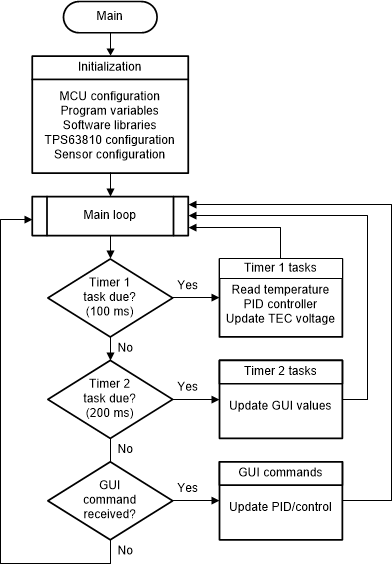SLVUBX1 December 2020 TPS63810
5 Firmware Overview
The firmware for the MSP-EXP432P401R LaunchPad is implemented in Energia. While this firmware is meant to be used with the MSP-EXP432P401R only, it can be easily modified for other TI LaunchPads. For this reason the BOOSTXL-TECDRV BoosterPack has multiple connection options for the BoosterPack header. By moving the jumper resistors, the signal and control lines can be re-routed between multiple pins. This is shown in more details in the schematic in Section 8.3.
Figure 5-1 shows the firmware flow chart.
 Figure 5-1 Firmware Flow Chart
Figure 5-1 Firmware Flow ChartThe code starts by initializing various variables, configuring MCU and its peripherals, and configuring digital sensors. After that the main loop takes care of three main processes:
- A 100-ms timer takes care of the main control process. Here, the temperature is read either from the analog sensor via ADC or the digital sensor via I2C. After that, the PID controller calculates the necessary control voltage for the TPS63810. This voltage is transmitted to the TPS63810 via the same I2C interface used for the digital temperature sensor, and the TEC voltage is updated. This period depends on the thermal dynamics of the system and can be changed in the code.
- A 200-ms timer periodically sends the currently sensed temperature and the current output voltage of the TPS63810 to the GUI. This period can be extended in order to send less data to the GUI. When used with the BOOSTXL-TECDRV GUI, it is not recommended to send the data more than 10 times per second, as the GUI might not be able to process all the incoming data.
- The third process checks if there is a message received from the GUI. These messages are sent from the GUI to the Launchpad on user commands, such as initializing the TPS63810 or changing the control modes and PID parameters.